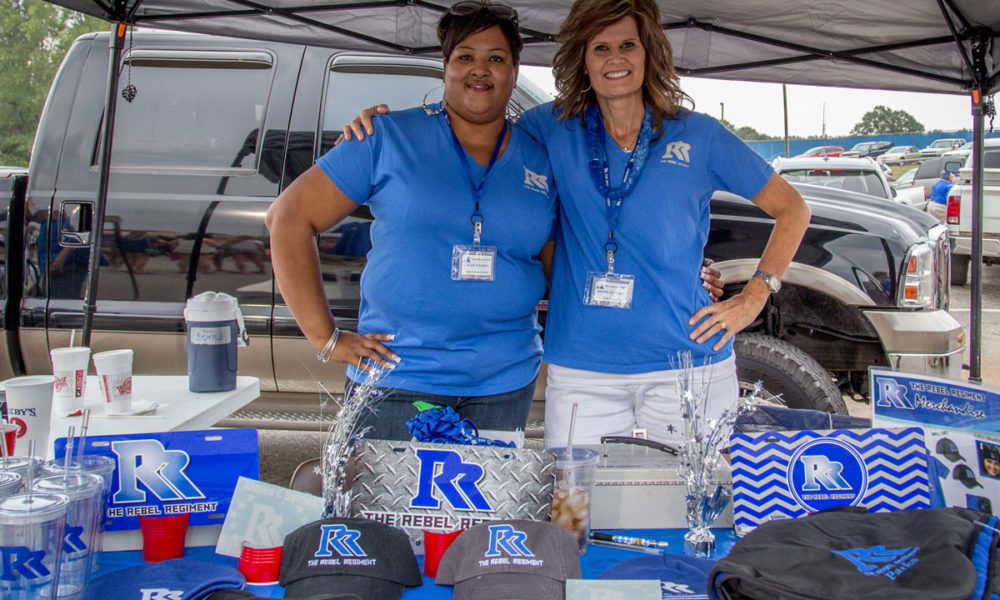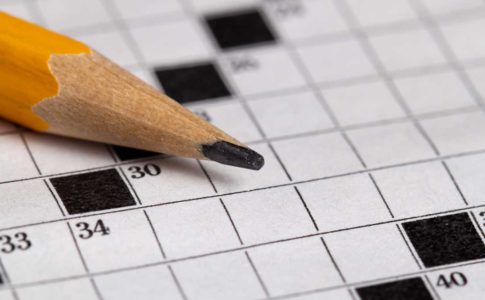Band boosters and parents can show their pride by purchasing merchandise that features the organization’s name and logo.
 When The Rebel Regiment from James F. Byrnes High School in Duncan, South Carolina, marches onto the field, its members can look up and see “a sea of blue,” says Beth Scholz, former merchandise chairperson for the Rebel Band Booster Club. “Everything we sell is a certain color of blue, and when the kids look into the stands, they can see how many people are there to support them.”
When The Rebel Regiment from James F. Byrnes High School in Duncan, South Carolina, marches onto the field, its members can look up and see “a sea of blue,” says Beth Scholz, former merchandise chairperson for the Rebel Band Booster Club. “Everything we sell is a certain color of blue, and when the kids look into the stands, they can see how many people are there to support them.”
Band swag, or logoed merchandise, not only gives band supporters a cohesive look but can also add a little bit of revenue to the organization’s bottom line.
While parents of The Rebel Regiment have always regularly and enthusiastically supported the band, the organized approach to selling band merchandise was not developed until 2015. “We started it from scratch three years ago,” Scholz explains. “We got approval from the director to sell a range of merchandise—not just T-shirts. We wanted ‘stuff.’”
“Stuff” includes ball caps, blankets, window decals, hooded sweatshirts, and yes, T-shirts. That first year, the booster board made a conscious decision to offer only a limited number of items, so it could measure the response from parents and students. “We also offered clear tumblers, cell phone cases, and decorative front license plates the first year,” Scholz says. “Those basically flopped, so we dropped them the following year.”
In the fall of 2016, the Rebel Band Booster Club added more merchandise, including rain ponchos, coin purses, coffee mugs, stadium seat cushions, and duffle bags. “We just ran with it,” Scholz says. “We relied on our experience as band parents and ordered the items that we would want to buy, use, and wear.”
Quantity and Quality
The same thinking applies to the Fort Mill (South Carolina) High School Band Boosters’ approach to offering merchandise, and the board also welcomes ideas from students, parents, and the director. “Inspiration for new items can come from anywhere,” says Caroline Austin, past president. “Then the booster board and band store committee decide together if we want to offer it, and we submit the ideas to our director for approval.”
Upon receiving approval to offer a particular item for sale, the Fort Mill band store committee takes over, first deciding how many individual pieces of that item to order. “If the vendor has minimum quantities per order, such as 50, we first start with that minimum to see how the item will do,” Austin explains. “If they become hot-ticket items, we order more. For example, lanyards were very popular last year, and we ended up ordering more of them.”
Certain “high-ticket” items are offered by pre-order only, Austin adds. “We offer fleece-lined jackets that are more expensive, and we only sell those by pre-order. We have a sample of each size, so they can try it on before ordering.”
The pre-order method works well for the Crimson Express and Company, the booster organization that supports the Murphysboro (Illinois) High School marching band. “We send home order forms with all the kids, and we also promote our merchandise through email and Facebook,” says Nancy Caskey, booster president.
The boosters typically place more than one order for merchandise throughout the season—especially after the first order comes in. “People start to wear their shirts or hoodies, and then everyone else sees them and wants one,” Caskey explains. “We hear comments like, ‘I didn’t know it was going to look that nice.’”
Typical items sold by the Crimson Express and Company include car decals, ball caps, blankets, jackets, hooded sweatshirts, and tumblers. “All our items feature our logo and our colors,” Caskey says. “We may switch out the colors from year to year—for example, offer a red ball cap with a gold logo one year and a gold ball cap with a red logo the next—so parents may be inspired to purchase new items from year to year.”
For Every Budget
Caskey notes that while many parents will buy new merchandise every year, not all band supporters have large budgets. “We try to offer items at a range of price points,” she says. “For example, the car decals have a lower price point, and many families have a decal on every car.”
The boosters at Fort Mill and James F. Byrnes also offer products in a range of prices. Austin has found that the parents at Fort Mill tend to purchase more items if they believe the products represent a good value—and they will continue to buy new merchandise every year.
“Students and parents can wear something with the Fort Mill logo, but it’s still affordable,” she explains. “When things start to get too pricy, people shy away from buying them, and then you are stuck with merchandise.”
When determining the retail prices for merchandise, the band store committee at Fort Mill tends to add just a few dollars to the actual cost of the products instead of applying a traditional retail philosophy of doubling the wholesale amount. “For example, if something costs $8 for us to purchase from a vendor, we typically will add $2 to the price,” Austin explains. “I would rather sell more of the item than have people turned off by the price.”
The boosters at James F. Byrnes add several dollars to the wholesale price of their merchandise, but the markup is also intended to cover the fees charged by the graphic designer who produces many of the designs that appear on the items. “We mark up each item from $4 to $6,” Scholz says. “We want to make a little money while covering our expenses.”
If something isn’t selling, however, Austin of Fort Mill recommends putting the item on sale or special. “People respond to language such as ‘limited quantities’ or ‘going fast,’” she adds. “By putting items on sale, we recoup some of our money and don’t have to store extra inventory.”
See, Touch, and Purchase
Fort Mill’s band store committee prominently displays sale items on its merchandise cart, set up during band practice on Tuesday and Thursday nights and at football games and community performances. “It’s a cart on wheels and has spots to hang up certain clothing items,” Austin explains. “We also set up an extra table.”
The boosters at James F. Byrnes operate a booth at all home football games, and Scholz believes the products sell well because people can see the products. “People want to see it and touch it and walk away with it,” she says, noting that brisk fall weather can also help with sales. “I can’t tell you how many sweatshirts I’ve sold because someone is cold.”
Still, even cold people want to wear something attractive and well-made—and that is a message Scholz believes all band organizations should keep in mind when selling merchandise.
“Be willing to spend a little money up front to create a good design,” she says. “If you would want to buy it and wear it, chances are your other parents will too.”


